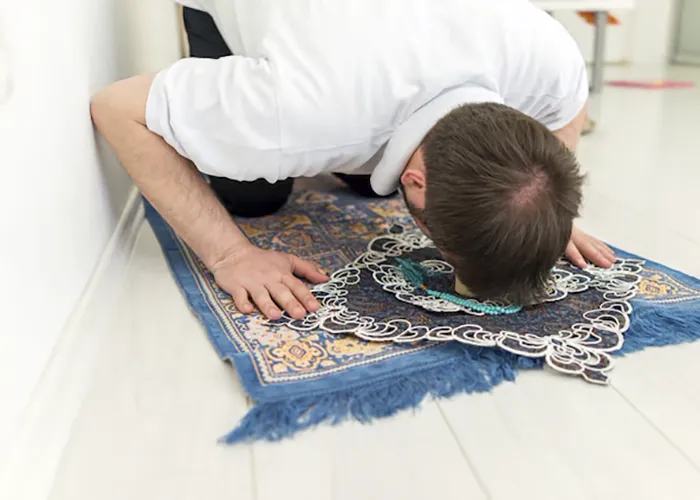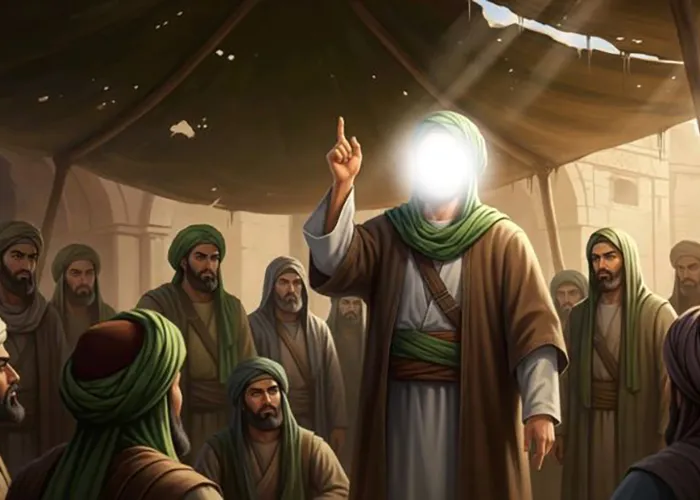Fatwa Panel of the Week – Volume02 Issue46
Obligatory Acts of Prayer
According to the fatwas of the Grand Religious Authorities: Ayatollah Sayyed Ali Khamenei, Ayatollah Sistani, and Ayatollah Makarem Shirazi (may Allah prolong their blessings):
Fatāwā presented without citing a differing opinion or a specific reference are the common rulings shared by the three respected Marāji‘. In cases where the ruling of one Marjaʿ differs from that of the other two, it is indicated in a footnote under the same number, mentioning the Marjaʿ by name.
Rulings of the Place of Prostration (Sajdah)
1. The place where a person puts one’s forehead for prostration (sajdah) should not be more than four joined fingers lower or higher than the place where one places one’s knees and the tips of one’s toes.
Ayatollah Sistani: In fact, the obligatory precaution is that the difference in height between the place where one places one’s forehead and the place where one stands must also not be more than four closed fingers.
Ayatollah Makarem Shirazi: The same rule applies to the position of the forehead in relation to the toes, whether the ground is sloped or level.
2. The prostration cube (turbah), or another item on which a person prostrates, should be pure and cleansed, but there is no problem if one puts the prostration cube (turbah) on a ritually filthy (najis) carpet. If one side of the prostration cube is ritually filthy (najis), one should place their forehead on the pure side.
3. There should be no barrier, such as hair or a hat, between the forehead and the prostration cube (turbah).
4. If there is any barrier between one’s forehead and the prostration cube (turbah), one’s prayer is invalid. However, there is no problem if only the prostration cube’s (turbah) colour has changed.
5. If, while performing prostration (sajdah), one notices that one’s forehead, due to a barrier, e.g., a headscarf or chador, is not in contact with the prostration cube (turbah), one should reposition one’s forehead or remove the barrier which separates one’s forehead from the prostration cube (turbah) until an area of the forehead the size of a fingertip at least, makes contact with the prostration cube (turbah) without raising the head from the ground. If one raises one’s forehead to remove the barrier and places it again on the prostration cube (turbah), whether absentmindedly or out of ignorance, and one did so in only one of the two prostrations (sajdah) of each unit (Rak’ah), one’s prayer is correct and there is no need to repeat it. However, if one raises one’s head and lowers it again intentionally or in both prostrations (sajdah) of a single unit (Rak’ah), their prayer is invalid.
6. In the first unit (Rak’ah) of all prayers and also in the third unit (Rak’ah) of all four-unit (Rak’ah) prayers, based on obligatory precaution, the praying person should sit after the second prostration (sajdah) and then stand up for the next unit (Rak’ah). However, standing up immediately for the next unit (rakʻah) does not invalidate the prayer.
Ayatollah Sistani: In the first and third rakʿahs which do not have tashahhud – as is the case in the third rakʿah of ẓuhr, ʿaṣr, and ʿishāʾ prayers – the obligatory precaution is that after the second sajdah, one must sit still for a moment and then stand up.
Ayatollah Makārim Shīrāzī: After the second prostration, in cases where tashahhud (the testimony) is not obligatory, it is recommended to sit for a brief moment before standing up for the next rak‘ah (unit of prayer).
Objects on which (sajdah) prostration is valid
1. In the prostration (sujūd) of prayer, the forehead must be placed on the ground or on plants that grow from the earth but are neither edible nor wearable—such as stone, soil, wood, tree leaves, and the like. Prostration on items that are edible or wearable, even if they grow from the earth, such as wheat and cotton, as well as on substances not considered to be of the earth, like metals, glass, and similar materials, is not valid.
2. Prostration on marble and other types of stone used for construction or decoration, as well as on agate, turquoise, crystal, and similar stones, is valid; although it is recommended, as a precaution, to avoid prostrating on the latter group (such as agate, turquoise, and similar gems).
3. Prostrating on brick, clay, gypsum, limestone, and cement is valid.
4. Prostrating (sajdah) on what grows on and from the earth and is served only as fodder for animals, e.g., grass, hay, is valid.
5. Prostrating (sajdah) on the green leaf of a tea plant is not valid based on obligatory precaution, but prostration (sajdah) on the leaf of the coffee tree, which is not edible itself, is valid.
6. Prostration on flowers that are not edible, as well as on medicinal herbs that grow from the earth and are used solely for treating illnesses—such as hollyhock and violet—is valid. However, prostration on plants that are also consumed for their medicinal properties in non-medical situations, such as khak-shir (flixweed) and the like, is not valid.
Ayatollah Makarem Shirazi: There is no problem in prostrating on grass, straw, and similar things that grow from the earth and are animal feed. Likewise, it is permissible to prostrate on flowers that are not edible for humans. However, as a matter of precaution, prostration on flowers and plants that are used as edible medicines — such as violet and borage flower (gol-gāv-zabān) — is not valid. The same applies to plants that are edible in some regions but not in others.
editor's pick
news via inbox
Subscribe to the newsletter.




